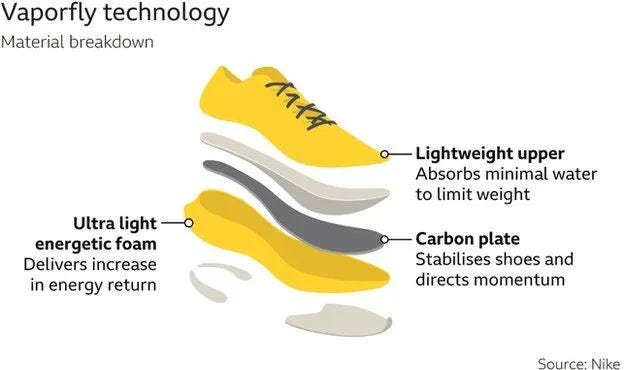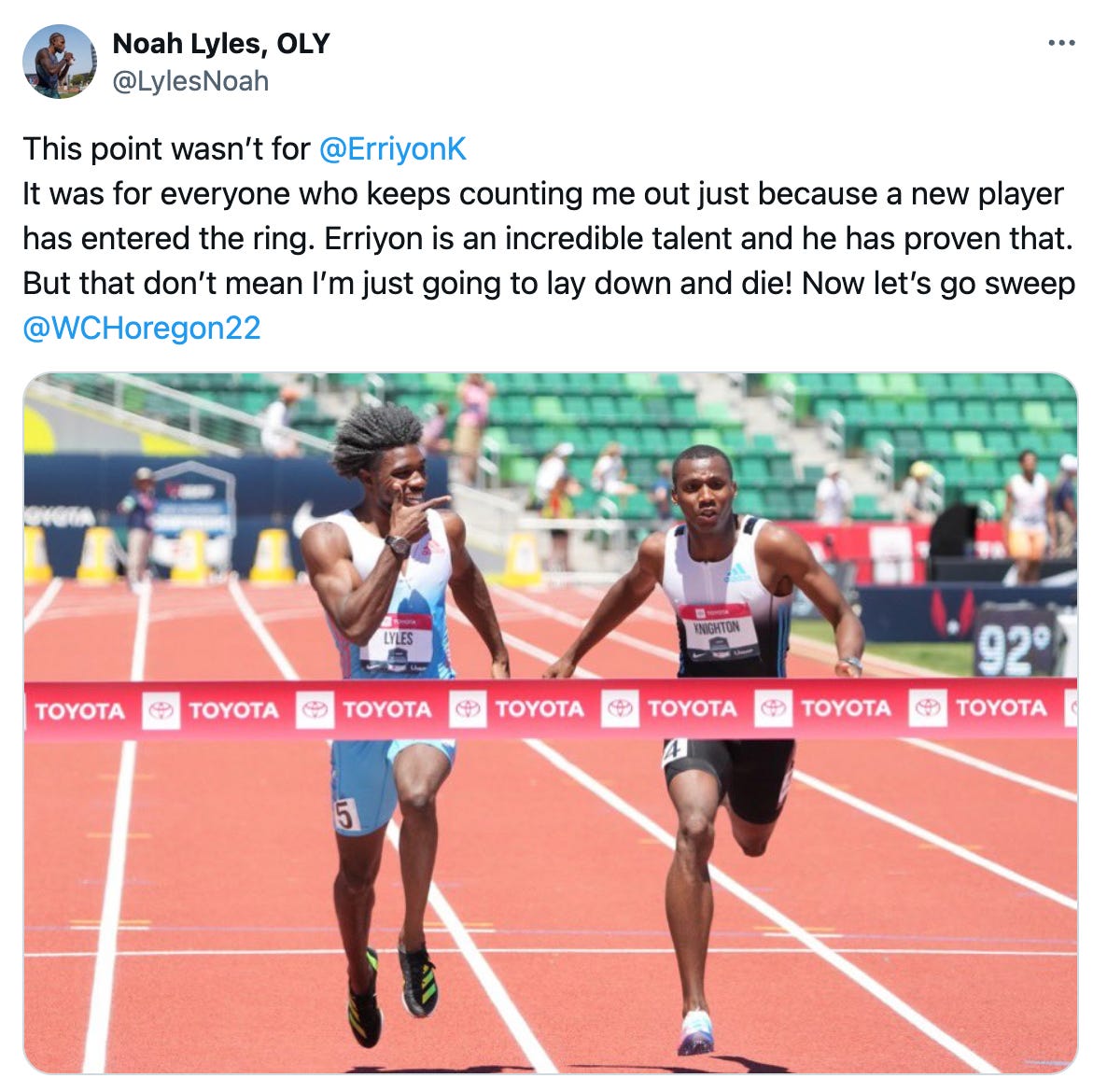POSITIVE AFFIRMATION
"Today I’m pushing beyong my previous limits.
Today I’m going to drink an extra cup of coffee."
During the 2022 final US trials for the 200-meter, the reigning World Champion Noah Lyles defeated the then-world-leading teenage sensation, Erriyon Knighton, and as he crossed the finish line, Lyles pointed his finger towards Knighton, sparking sportsmanship controversy.
We’ll get back to what that was all about.
I was recently out of my normal workout and running routine for a month, thanks to a monster sickness that knocked me down hard. (Ref recovery.) When I finally resumed running, I was shocked at how out of running shape I was. Typically I end a run with a short, all-out sprint, to burn up any remaining bit of energy. That’s what led me to learn how to run faster and meet Evan Gregory, coach and trainer of Olympic-level athletes, who gave incredible insights on what that takes - so catch up on that! Plus, if I ever need to run away from a bear, I need to be faster than the friend I’m hiking with.
Similarly our productivity, like sprinting, could degrade if we don’t use it. And if we want explosive moments of productivity, where we can crank it up to 100… well, that’s gonna take the right kind of productivity training.
Let’s break down the mechanics of explosive productivity.
1 - Power Focus
I see focus as the willpower and ability to immediately hunker down, tune out distractions, and focus on the task at hand. Like other muscles, we can strengthen it by exercising it under periodic load.
“Periodization is defined as the planned manipulation of training variables (load, sets, and repetitions) in order to maximize training adaptations and to prevent the onset of overtraining syndrome.” - NIH Paper
That means sometimes you focus hard for a few minutes, other times you stretch it longer. The key is to introduce variety so that the brain doesn’t get accustomed to only one setting, forcing it to adapt. A sprinter doesn’t only train in short, explosive bursts; they also do strength and endurance training.
DO THIS: If you’re at work, pre-decide if you’re aiming to give the meeting or task at hand a level of focus of 5 minutes, 20 minutes, or maybe even up to an hour. But keep a variety throughout the day and only do longer durations of focus sparingly.
2 - Expert Tools
Whether on your phone, your laptop, or online, do you have the tools (i.e. apps, software, screen layout) to generate great results? Basic tools such as Word/Doc, Excel/Sheets, note-taking programs, and reminder apps are obvious. For an elite runner, specialized ‘gear’ is also warranted, like the latest craze of carbon-plated shoes.
“The amount of 'work' that the ankle joint, and surrounding structures, have to do at a given workload is reduced by the carbon plate because it essentially helps the natural rolling process. The curve of the carbon plate helps forward momentum and helps to lift the heel of the shoe faster. Carbon plates also enhance energy return by adding structure and stability to the midsole foam.” - Jon Reilly, Tri Training Harder Coach
Carbon-plated shoes aren’t for everybody though.
“About 30% of runners saw RE improve with the increased bending stiffness while 27% saw it deteriorate, with results ranging from 3% improvement to 3% deterioration. And finally, 43% of runners showed no change whatsoever.” - Salomon Skills & Advice Column
DO THIS: Use the gear, aka tool, that’s appropriate for you. Just like how you shouldn’t use too heavy of weights because it causes bad technique and form, it defeats the purpose. If you like simple, don’t get the most advanced, complicated organization and reminder app. But if you’re a detailed planner needing specialization, don’t skimp out with free apps. Train and work with the tools that are meant for you.
3 - Advanced Competency
Do you know what you’re doing? Sprinting wrong could lead to injury. Being productive wrong could mean wasted time and a bad product. Like training before a big race, it means you need to take the time to learn and practice being productive when there’s no pressure. Practice your craft - writing, art, data crunching, programming, whatever. Commonplace makes competence. And once you’ve developed the habit and muscle memory, you’ll be ready for the big race, i.e. big presentation to upper management.
DO THIS: Read several articles, research papers, books, and/or classes on your tradecraft. Learn all about it and then put into practice the concepts in low-stress situations, i.e. day to day. For someone like me who writes about productivity, I read tons of stuff and put it into practice thru my weekly Venture Out writings. The big day will come one day when I’ve written my book on productivity and overtake James Clear’s Atomic Habit as the bestseller! I’m coming for you James Clear!!
TAKEAWAY
Back to the top about the controversial finger point by Noah Lyles. He explained what it really meant:
I guess for me, I’d be finger-pointing at that monster virus that knocked me down for a month. Whether it be the next daycare sickness my baby gifts me or my aging body, I’m not going to stop trying to improve. Let’s do that together!
(precision productivity training)
➩ Don’t miss out on last week’s article & podcast with Evan Gregory, who is Noah Lyles coach! Get inside the mind of what it takes to train the fastest man in the world.
➩ I’m 25% into Gloria Mark’s Attention Span: A Groundbreaking Way to Restore Balance, Happiness and Productivity and picking up some interesting frameworks on concepts like distraction, types of attention, and what it could mean to gain more efficiency in our day-to-day life. I’ll report more on this soon!
➩ Ben Saunders, a record-breaking polar explorer, 3x TED main stage speaker, and climate tech investor, has his own… podcast! Haha, I love it. But he’s got some truly great guests, like Alex Honnold of Free Solo and Rainn Wilson of The Office. Also available on Spotify.




